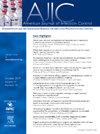使用点自助终端改善医疗机构 N95/P2 呼吸器密合度的评估:随机对照试验
IF 3.8
3区 医学
Q2 INFECTIOUS DISEASES
引用次数: 0
摘要
简介:验证一次性 N95/P2 半面式呼吸器是否合适至关重要。目前还没有客观的方法来评估使用时的执行情况。方法:使用四种不同款式的呼吸器,对 166 名受试者进行了 657 次密合度定量测试。进行了随机分组;对照组采用标准的 "密合度检查",干预组采用定制的红外线视频亭。主要结果是定量密合度合格率,次要结果是呼吸器类型、性别、种族和以往经验:结果:与对照组(30.8%)相比,干预组的通过率(50.6%)明显更高。与对照组相比,使用 IR Kiosk 的通过率为 2.3(OR 2.3 95%CI 1.8 至 2.9,p):与参与者的人口统计学特征无关,定制的使用点自助服务终端提高了常见呼吸机款式的合格几率。这些发现为解决呼吸保护计划中的一个关键缺口打开了大门,即在风险最高的时候提供个体评估和干预措施,从而提高工人的安全:支持本研究结果的数据可向通讯作者索取。由于数据中包含的信息可能会损害研究参与者的隐私,因此不对外公开。本文章由计算机程序翻译,如有差异,请以英文原文为准。
Evaluation of a point-of-use kiosk for improving the fit of N95/P2 respirators in health care settings: A randomized controlled trial
Background
Fit of N95/P2 half-face respirators is critical. No objective ways exist to evaluate their implementation at use. Previously, we showed 26% of health care workers achieve appropriate fit at point of use.
Methods
657 quantitative fits were conducted on 166 subjects, using 4 different respirator styles. Randomization was performed; controls employing standard “fit-check” and intervention using a infrared video kiosk. Primary outcome was passing rates of quantitative fit, with secondary outcomes of respirator type, gender, race, and previous experience.
Results
Intervention demonstrated significantly higher pass rate (50.6%) compared with controls (30.8%). Odds of passing with kiosk was 2.3 (odds ratios [OR] 2.3, 95% confidence intervals [CI] 1.8-2.9, P < .001). Duckbill style improved the greatest (OR 4.1, 95% CI 2.1-7.9, P < .001), and Tri-fold also showing substantial benefit (OR 2.66, 95% CI 1.4-5.2, P < .001). Gender and race did not influence outcomes when using the kiosk, nor did previous experience.
Conclusions
A custom point-of-use kiosk improved odds of achieving a satisfactory fit of common respirator styles, independent of participant demographics. These findings open the door to addressing a gap in respiratory protection programs by providing individual assessment and interventions that improve worker safety at the time of highest risk.
求助全文
通过发布文献求助,成功后即可免费获取论文全文。
去求助
来源期刊
CiteScore
7.40
自引率
4.10%
发文量
479
审稿时长
24 days
期刊介绍:
AJIC covers key topics and issues in infection control and epidemiology. Infection control professionals, including physicians, nurses, and epidemiologists, rely on AJIC for peer-reviewed articles covering clinical topics as well as original research. As the official publication of the Association for Professionals in Infection Control and Epidemiology (APIC)

 求助内容:
求助内容: 应助结果提醒方式:
应助结果提醒方式:


